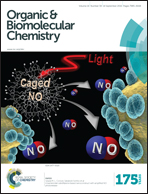A regioselective double Stille coupling reaction of bicyclic stannolanes†
Abstract
A regioselective double Stille coupling reaction was explored using bicyclic stannolanes that were easily prepared from the radical cascade reaction of β-amino-α-methylene esters. Various 1-bromo-2-iodoarenes underwent the double coupling reaction to afford benzoisoindole derivatives in a regioselective manner, where the carbon attached to the iodine selectively coupled with the vinylic carbon, and then the carbon attached to bromine coupled with the alkyl carbon. The combination of intra- and intermolecular coupling reactions provided hexahydroindeno[1,2-b]pyrrole derivatives in good yields. The yields were further improved in the presence of excess amounts of CsF. An attempt to identify the reaction intermediate was made wherein the decomposition of the stannolanes with aqueous HCl and HBr afforded trigonal bipyramidal (TBP) pentacoordinated tin complexes, as confirmed by microanalyses and 119Sn NMR. Using DCl for the decomposition selectively introduced a deuterium to the E-position of the exomethylene unit. The complexes smoothly underwent the intramolecular Stille coupling reaction in the presence of both a palladium catalyst and DABCO, affording hexahydroindeno[1,2-b]pyrroles in good yields. These results suggest that the double coupling reaction progresses through a TBP tin complex, promoting the second intramolecular coupling reaction between the aryl halide and Csp3–tin bond.


 Please wait while we load your content...
Please wait while we load your content...